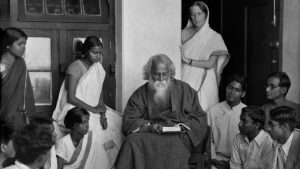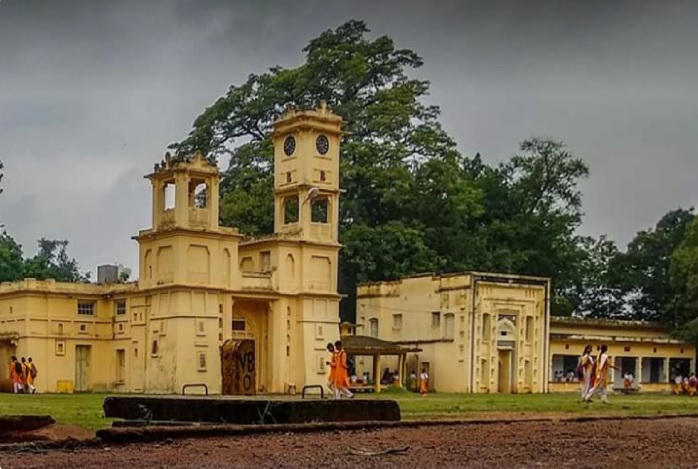Krispin Joseph PX
Poet Rabindranath Tagore founded Visva Bharati after long travels into different countries’ diverse topography and knowledge systems. Tagore understands the learning system of the West, and he blended it with Eastern ideas, an Indian style of ‘seat of learning’. This institute is considered a visible body of the Tagorian vision of life, learning and understanding. Visva-Bharati (The communion of the world with India) is a platform for scholars and learners worldwide to gather together and learn. Through Visva-Bharati, Tagore founded a learning system from the Guru in a natural ambience. The basic principle of Visva-Bharati is based on ‘Harmony with all existence’, and that harmony is a blend of nature, human surroundings and international relations.
Visva-Bharati intends to settle the problems of the learning process and the theory to practical, as Tagore visualised. Visva-Bharati was founded as Ashram for learning; both ‘teacher’ and student stay together and learn under the same tree of wisdom (Visva-Bharati developed out of Santiniketan Ashram, founded by the poet’s father, Maharshi Devendranath, in 1863). For this, Tagore crystallised his ideas of a system of learning. Visva-Bharati embodied the Tagorian vision of a knowledge institute containing a magnitude of scholarly and innovative aspirations.
How did Tagore establish his visions in this institute, and how do we understand this in an aesthetic sense? What is the aesthetics of Visva-Bharati that brings into reality and practice of learning knowledge and wisdom directly from the Guru (teacher), as the ancient Indian knowledge system worked? Through Visva-Bharati, Tagore implemented an atmosphere of love of learning and the organic growth of a soul.
Subhajit Jana writes about Tagore’s Visva-Bharati: An Inclusive Society (2018) and thinks loud, ‘An inclusive society means a society where every people and people of the different societies of the world live together and share their feelings and thoughts. Visva-Bharati is a society where universal knowledge and global cultures are included. So, Visva-Bharati is a single nest of the world’s people (p827). According to Jana, Visva-Bharati is the most significant Innovation of Tagore, which is globally accepted and popularised because of the inclusive nature of the institute regardless of gender, different age, and rural and urban people. This ingenious nature of the institute comes from Tagorian humanism and internationalism.

For Visva-Bharati, there is an ancestor in the Tagorian family residence in Jorasanko: established Bichitra Studio for Artists in 2017 by Tagore and Nandalal Bose, Asit Haldar and Mukul Dey as the founding members, and Abanindranath Tagore its first master, Gaganendranath Tagore its director, Sir John Woodroffe, Messrs Blount and Muller the visitors, and Rabindranath its secretary and treasurer. This intellectual group gives the nature of the ‘ideal image of India on the one hand, and openness towards other cultures on the other’. A very before this, ‘Bichitra Studio’, in 1907, established the Indian Society of Oriental Art by Abanindranath Nath Tagore, which helped many Asian scholars and Indian lovers to understand what is Indian art and Culture. The Indian Society of Oriental Art has been the flagship movement in Modern Indian art and Culture for a long time and has conducted art shows, including the Bauhaus exhibition in 1922, just after the foundation of Visva-Bharati.
Gurukula’s teaching method is replaced in this institute with eminent scholars from worldwide, and students are flooded to Visva-Bharati from around the world. Students and teachers stay inside nature, living beings of nature, inclusive space for man and his soul. Tagore believes nature is the best teacher for people worldwide, and that system will help people learn about nature, behaviour and character. ‘By the ideas about the reconstruction of village life, a new type of school meant mainly for the children of neighbouring villages who would eventually bring the offering of their acquired knowledge for the welfare of the village community was also conceived, write Jana (p829).
Swati Ganguly’s book (2022), ‘Tagore’s University: A History ofVisva-Bharati 1921-1961’, she writes about the history and the aesthetics of Visva-Bharati. In the aftermath of the first world war, Tagore visited the US and Japan and delivered a lecture on nationalism. He thought of starting a habitation for liberal and like-minded intellectuals and creative people. Through the foundation of Visva-Bharati, Tagore opened his dream to everybody interested in liberal arts and scientific studies. ‘Thought of as a haven for the best minds across the world during the devastating years of the First World War, Visva-Bharati represented a radical rethinking of the relationship between “self” and “other” – the notion that the self can only be conceptualised and enriched by exchange and cooperation with the “other”, Swati Ganguly writes (p4).
Visva-Bharati was a significant move towards the ideological topographies and aesthetics because the world awaited this from the East. The West was in colossal loss of humanity in war-time crimes and crises. The Tagorian concept of sharing knowledge is basic because ‘Visva-Bharati was conceived as the antithesis of imperial arrogance; its core presupposition was the possibility and desirability of cooperation among Asians and Europeans in a non-hierarchical mode within a sylvan habitat, as writes Swati. Tagore understands what the world wants from the Indian socio-political settings and tries to bring those necessities to a form.
‘This history of Visva-Bharati evokes its founder, but the Rabindranath here is different from the one who lives in the popular imagination as a poet, mystical philosopher, and artist. His involvement in Visva-Bharati shows a different aspect of his creativity. In this context, Rabindranath is an astute thinker laying down a broad intellectual framework of investigations in fields as diverse as Buddhist philosophy, the anthropology of medieval rituals, and the lexicography of ancient languages. He is as interested in discovering the principles of agricultural economics as in developing modes of exchange that might benefit hinterland artisans, writes Swati.
Swati Ganguly writes well about the interlinks between Tagore and Visva-Bharati. What we are experiencing as a university is a concept of learning and distinguishing knowledge and wisdom. Tagorian idea of ‘school’ stood in Indian soil, aesthetics, and classical Indian thought of education. We can find the ultimate insight from the narrow path of surrounding nature and the scholars who open the students’ eyes to the realities and practical life experiences. Tagorian idea of education and knowledge was founded and flourished in the last century and fed many people regardless of their identity and belongingness.

Krispin Joseph PX, a poet and journalist, completed an MFA in art history and visual studies at the University of Hyderabad.





